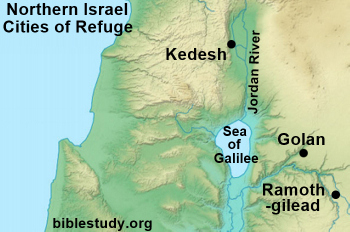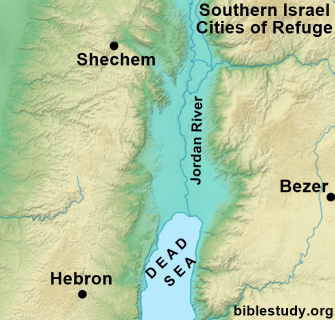A little background is needed before we delve into discussing these unique cities. One of the main reasons why the Eternal saved the children of Israel from Egyptian bondage was to fulfill his promise to Abraham (Genesis 12:7, 15:18). Seven years after the Israelites entered the Promised Land it was divided up amongst the tribes by lot (Joshua 14).
The priestly tribe of Levi, however, did not receive territory, as God was their inheritance (see Numbers 18:20, Deuteronomy 18:1 - 2). They were given, instead, forty-eight towns throughout Canaan in which they could live and maintain the knowledge of God. Six of these locations were designated as cities of refuge.
Three of the cities were located on the west side of the Jordan River and three were east of it. Those on the west were Kedesh (in the land of Naphtali), Shechem (in the western part of Manasseh's inheritance) and Hebron (in the land of Judah). Those on the east were Golan (in the land of Bashan), Ramoth-Gilead, and Bezer (in the land of Reuben).

Strategic Locations
The towns were strategically chosen so that anyone living in Israel, including strangers (Joshua 20:9), could flee to them within a day or less.
"Corresponding to the care for the proper location of these (asylum) cities were the other ordinances referring to them. The roads leading to them were marked by sign-posts at the crossroads, with the inscription "Miklat" (Refuge); the roads were very broad . . . smooth and level, in order that the fugitive might not be hindered . . ." (1906 Jewish Encyclopedia).
God Commands It
God commanded Joshua to create cities of refuge for his people Israel.
Speak to the children of Israel, saying, appoint cities of refuge for you, as I (God) have spoken to you (Joshua) by the hand of Moses;
That the manslayer who in innocence strikes anyone mortally, without knowing, may flee there. And they shall be your refuge from the avenger of blood.
And he shall flee to one of those cities, and shall stand at the entrance of the gate of the city, and shall declare his cause in the ears of the elders of that city. And they shall take him into the city to themselves and make him a place, and he shall live with them.
And if the avenger of blood pursues him, then they shall not deliver the manslayer into his hand, for he has struck his neighbor without knowing, and did not hate him in past time.
And he shall live in that city until he stands before the congregation for judgment, until the death of the high priest who is in those days. Then the manslayer shall return and come to his city, and to his house, to the city from where he fled . . .
These were the appointed cities for all the children of Israel, and for the stranger who was living in their midst, that he who had killed anyone without knowing might flee there and not die by the hand of the avenger of blood, until he stood before the congregation. (Joshua 20:2 - 6, 9, HBFV).
Why Were They Needed?
God deemed refuge cities were needed because the He acknowledges that people sometimes die due to an accident and sometimes on purpose. An unintentional death can take place if, while men are cutting down trees, an axe head breaks and fatally wounds someone (Deuteronomy 19:5). An intentional death occurs when someone is killed "with malice," meaning that they perish at the hands of someone who hates them.
Upon entering one of the special cities a person had to first explain, to local elders, what happened (Joshua 20:4). They were then given a place to stay until a trial could be conducted (Numbers 35:12).

Guaranteed Protection
A refuge city guaranteed the safety of those seeking asylum against being killed in retaliation by the "avenger of blood" (Joshua 20:3). This "avenger" was usually the nearest kin of the person who died. It was considered their duty to revenge the death of their family member (Joshua 20:9).
If it was determined that the accused accidently caused the death of another human, they could live, protected, from the "avenger of blood" only if they stayed in that location. They could only safely return to their home after the death of the High Priest (Joshua 20:6). If they left before the priest died, they risked being killed by the "avenger" who could kill them, outside of these protected cities, without penalty (Numbers 35:26 - 28).
If the accused was convicted of murder, they were turned over to the avenger of blood. The avenger was then to carry out the death penalty (Numbers 35:19, 21, Deuteronomy 19:12). Those who killed, either accidently or with malice, were not allowed to pay a ransom in the cities of refuge in order to avoid the consequences of their behavior (Numbers 35:31 - 32).